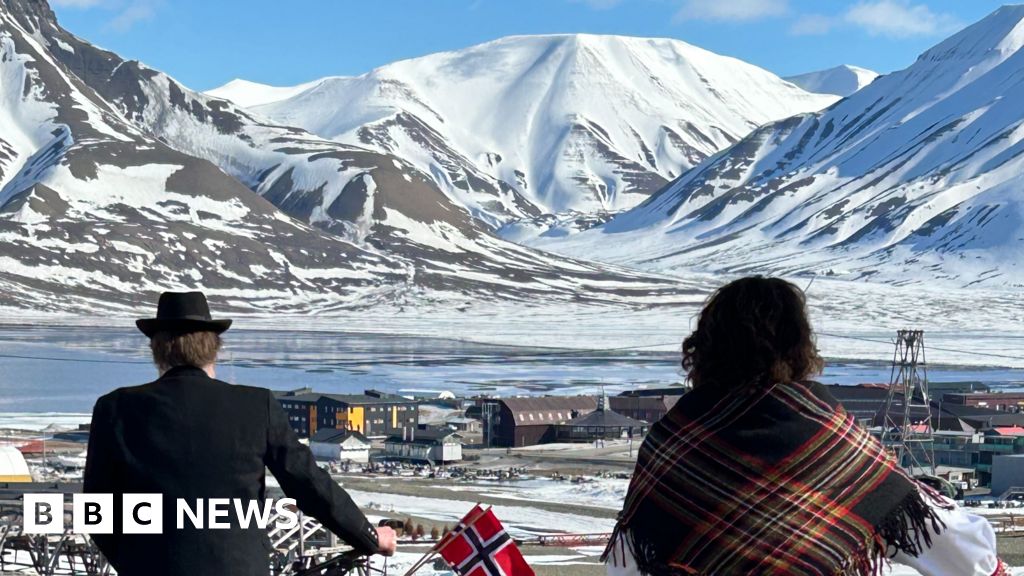Europe editor
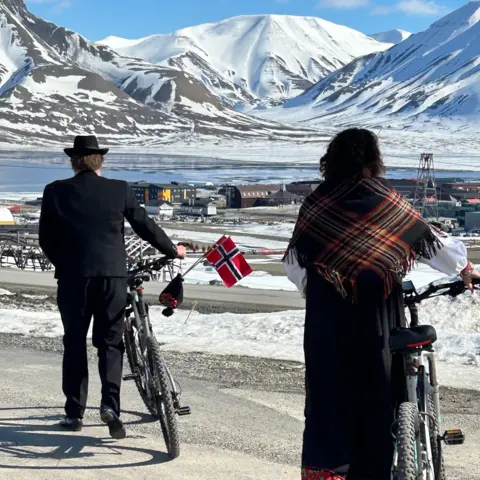 BBC
BBCAs soon as Magnus Mæland became mayor of a small town on Norway’s northern tip in late 2023, three delegations from China came knocking on his door.
“It’s because they want to be a polar superpower,” he tells me.
China might not instinctively spring to mind when you think about the Arctic – but it’s determined to be a big Arctic player. It’s been vying to buy real estate, get involved in infrastructure projects and hopes to establish a permanent regional presence.
China already describes itself as a “near-Arctic state”, even though its northernmost regional capital Harbin is on roughly the same latitude as Venice, Italy.
But the Arctic is fast becoming one of the most hotly-contested parts of the world. Beijing faces stiff competition from Russia, China, Europe, India and the US.
The race for the Arctic is on.
Climate scientists say the Arctic is warming four times faster than anywhere else. This impacts ecosystems, wildlife and local populations. The Arctic is enormous, encompassing 4% of the globe.
But global powers see a new world of opportunities opening up in the Arctic on the back of environmental changes.
The melting ice in the Arctic makes it easier to access the region’s incredible natural resources – critical minerals, oil, and gas – around 30% of untapped natural gas is said to be found in the Arctic.
And it’s opening up possibilities for new maritime trade routes, drastically reducing travel time between Asia and Europe. In the export business, time is money.
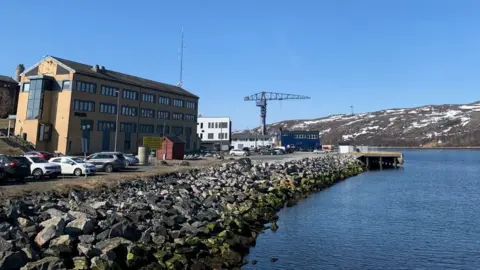
When I visit, Kirkenes port looks pretty ghostly.
Inside the Arctic Circle, at the northernmost point of mainland Norway, the former mining town is a gritty contrast with the picture-postcard, snow-covered mountains and fjords that surround it.
There are shuttered shops and abandoned warehouses, riddled with broken windows. The town feels forgotten and left behind.
So you can imagine the appeal of the possibility of becoming the first European port of call for masses of container ships from Asia, depending on how fast the polar ice continues to melt.
The town’s port director, Terje Jørgensen, plans to build a brand new international port. His eyes light up when he talks about becoming the Singapore of Europe’s High North.
“What we’re trying to build here in Kirkenes is a trans-shipment port where three continents meet: North America, Europe and Asia. We’ll take the goods ashore and reload onto other vessels [for further export]. We don’t need to sell any land to anyone. Not to a UK company, not a Chinese company.
New laws in Norway prohibit the transfer of property or businesses, if the sale could harm “Norwegian security interests”, he says. What they’re waiting for, he adds, are clear guidelines from the government about what kind of critical infrastructure this might cover.
Mayor Mæland certainly seems wary of China’s intentions. “We want a relationship with China, but we don’t want to be dependent on China,” he tells me.
“Europe has to ask itself ‘How dependent do you want to be on totalitarian and authoritarian regimes?'”
China’s purchase-your-way-into-the-Arctic approach is beginning to be rejected across the European Arctic. Recent attempts by Beijing to buy into seaports in Norway and Sweden and an airport in Greenland, for example, were rebuffed.
This is pushing polar-hungry China – the biggest emerging superpower in the world – into the arms of the Arctic’s largest player, Russia.

Russia controls a whopping half of the Arctic shoreline – and it’s been hoovering up Chinese investments.
The two countries cooperate militarily in the Arctic too. China’s coastguard entered the Arctic for the first time in October, in a joint patrol with Russian forces. The two countries had staged joint military exercises here the month earlier. In July, long-range bombers from both countries provocatively patrolled the Arctic Ocean near Alaska in the United States.
It’s as if Beijing and Moscow are looking over at Nato, which has stepped up its exercises in the Arctic, and are saying: We can do this too.
Every country bordering the Arctic is a member of Nato except Russia. Finland and Sweden joined after the full-scale invasion of Ukraine.
Andreas Østhagen, a senior fellow at the independent Fridtjof Nansen Institute, describes the Arctic as “low-hanging fruit” for Russian-Chinese collaboration.
“Russia needs investments and commercial actors who are interested in developing the Arctic – LNG [liquefied natural gas] resources, oil resources, or developing a northern sea route as a shipping lane.
“China is that market. The two countries are looking for ways to expand their political, economic, even military cooperation.”
But China is keen not to align itself too closely with Russia. It wants to avoid Western sanctions and to continue doing business with Western powers, inside and outside the Arctic.
Russia has reservations too.
“Be careful not to overrate the Russia-China relationship,” says Mr Østhagen. “Russia remains wary of letting China too deep into its Arctic.”
Moscow relies heavily on its natural resources there. And it’s courting other Arctic investors too, including the US, according to reports.
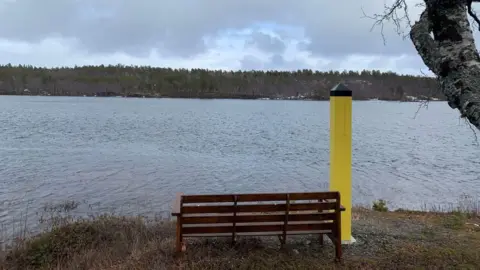
Russia also relies on its Arctic to store strategic weapons – mainly on its Kola peninsula, which bristles with nuclear capabilities and is home to its legendary Northern Fleet.
Back in Norway, Kirkenes residents live under that shadow of the Russian Bear next door. They always have. The border with Russia is a 10 minutes drive away by car. And Kola peninsula feels uncomfortably close.
In Cold War times, the town became known as a nest of spies – a frontline between the West and the Soviet Union.
Norway believes Russia is using its Arctic to train new recruits to fight, and to fly bombers from, to attack Ukraine.
Though not directly at war with Russia, Norway, and specifically the north of the country along its roughly 200km long land border, feels under attack.
“We see it here locally,” says Col Jørn Kviller, speaking to me by the clear waters of the Pasvik River that separates Norway and Russia. Just in front of us are Norway’s bright yellow, and Russia’s red and green, border posts.
Since the full-scale invasion of Ukraine, there have been increasingly frequent incidents of GPS jamming that have even caused commercial pilots to change navigation systems. Cases of espionage by the border – “everything from signals intelligence to agents being sent to Norway” – have shot up, Col Kviller tells me.
Norway and its Nato allies are also on the alert for Russian spy submarines and other vessels in the Arctic.
I get to see how Norway monitors this threat, after we get high security clearance to enter the country’s Cold War-era joint military command. It’s deep inside a quartz mountain in Bodø, within the Arctic Circle.
We find a labyrinth of tunnels and surveillance rooms where Norway gathers real-time intelligence from land, air and sea, focused on suspicious-looking vessels in and near its Arctic waters. Everything is shared in real-time with Nato allies.
Crucially, any Russian vessel wanting to enter Europe has to pass through Norwegian waters first.
Agents in the mountain HQ are on the lookout for signs of espionage and sabotage around what officials call underwater “critical infrastructure” as part of the Kremlin’s hybrid warfare against the West.
Targets include undersea communications cables – connecting continents and permitting trillions of dollars’ worth of financial transactions a day – and also oil and gas pipelines.
Norway is a major supplier of natural gas to Europe, including the UK, especially since sanctions were imposed on Russian exports following its full-scale invasion of Ukraine.
Moscow has been modernising its military capabilities in the Arctic. It has a serious fleet of spy and nuclear submarines. If they pass undetected, they could potentially target missiles at capitals across Europe and also threaten the US.
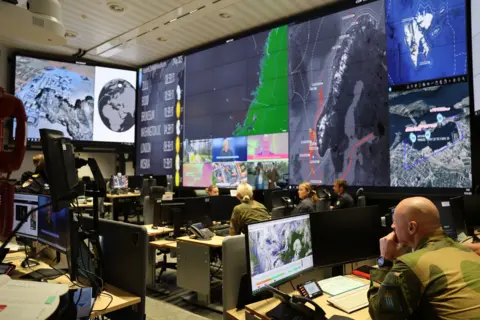
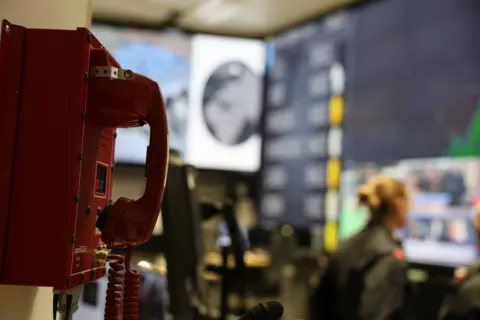
US President Donald Trump has told Europe it must do more for its own defence, but inside the Arctic, there is a “great overlap of interests”, says the chief of the Norwegian joint headquarters Vice Adm Rune Andersen.
“This is also about US homeland defence… The Russian concentration of nuclear weapons, the capabilities that Russia is deploying are not only aimed at Europe, but also at the US,” he says.
Vice Adm Andersen doesn’t believe any party is courting open conflict in the Arctic but with global tensions rising elsewhere, such as over Ukraine, the potential for spillover in the Arctic is there.
The vice admiral’s team schedules a routine call to Russia’s Northern Fleet every Wednesday afternoon -to keep communication channels open, they say. Just in case.
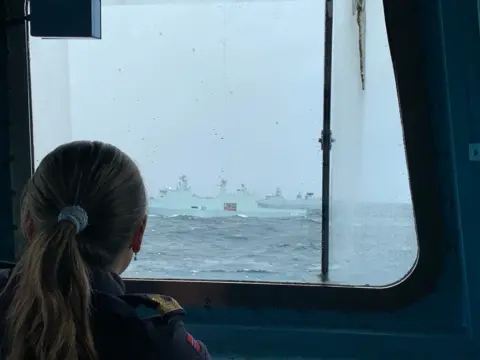
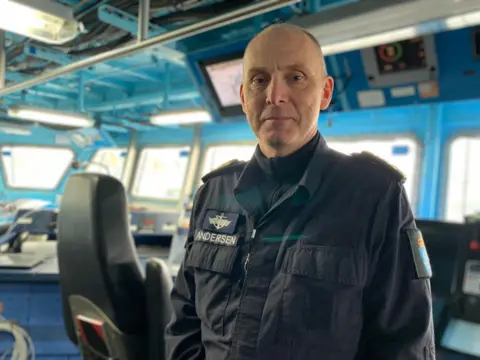
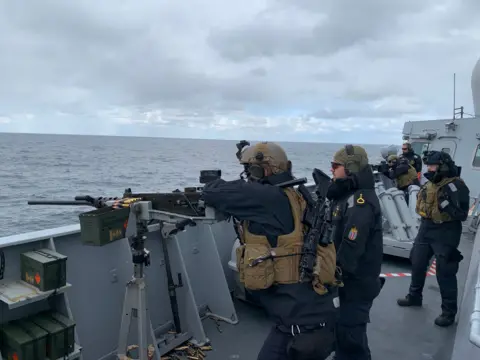
If you leave Kirkenes and head towards the North Pole, you come across the magnificent Norwegian archipelago of Svalbard at about the half-way mark. It’s home to ice floes, glaciers and more polar bears than people.
Svalbard is at the heart of the scramble between global powers for Arctic resources. While Norwegian, the archipelago is governed by a treaty allowing people from all countries that signed it to work there visa-free. Most are employed in mines, tourism and scientific research.
That may sound harmonious, but since the full-scale invasion of Ukraine there’s been a noticeable flexing of nationalist muscles in some communities here.
They include military parades by the Russian settlement to mark their commemorations for the end of World War Two, the flying of a Soviet flag over Russian infrastructure, and growing suspicion that the Chinese have made their Svalbard research station dual-purpose – for military espionage.
Regardless of whether or not that’s true, local mayor Terje Aunevik says it would be naïve to suggest there was no intelligence-gathering going on in the different countries’ research centres.
“Of course there is… I think the world has been gripped by Arctic fomo [fear of missing out].”
The day I arrive in Svalbard, it’s Norway’s national day. The streets are thronging with a snaking parade of mums, dads and children from the local school, clad in Norwegian national dress.
Longyearbyen is the northernmost town in the world. Bright sunshine glints off the Arctic waters below the main street, and the flat-topped, snow and ice-covered mountains all around.
Everywhere I look, I see shop windows, prams and women’s hairdos festooned with blue, white and red Norwegian flags. Perhaps I imagined it, but among all the cheeriness, it felt like there was another, unspoken sentiment that day, a reminder: ‘Svalbard belongs to us!’
The rising mood of national rivalries in the Arctic is not without consequences.
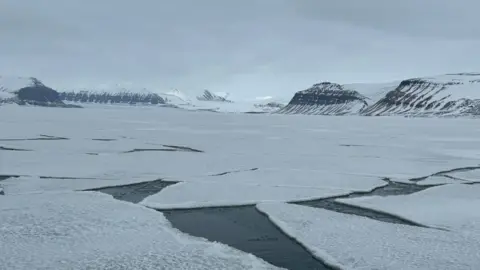
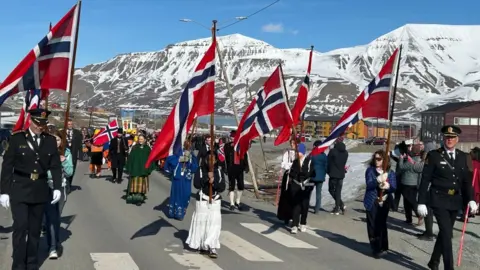
Indigenous communities in the region, just over half of whom live in the Russian Arctic, often feel that there is a failure on the part of those in power to acknowledge the rights of the peoples who have long called the region home.
Miyuki Daorana, a youth activist from Greenland representing the Inughuit indigenous community, says when Donald Trump claimed he wanted to buy the country during his first presidency, they laughed it off. But this time it feels different, she says.
“Because of the current global political situation, with power play and competition for resources, it’s much more serious.”
She, and others in the indigenous communities, accuse European countries of using the “climate crisis” as an excuse to “extract and invade indigenous lands”.
“It’s something we call green colonialism or developmental aggression where they really want to just take more and more from lands,” she says.
“[The Arctic] is not just a topic for us. It’s not just an interest, it’s not a study. It’s literally our lives and real struggles and emotions and very unfair injustices.
“The government and the politicians, they’re supposed to work for the people. But I haven’t seen that. It’s mostly diplomatic words.”
Not long ago, you used to hear talk of Arctic exceptionalism, where the eight countries bordering the Arctic – Canada, Russia, the US, Finland, Sweden, Norway, Denmark and Iceland – along with representatives of six Arctic indigenous communities and other observer countries, including China and the UK, would put aside political differences to work together to protect and govern this incredible part of the world.
But these are times now of big power politics. Countries increasingly act in their own interests.
With so many rival nations now in the Arctic, the risks of misinterpretation or miscalculation are high.
